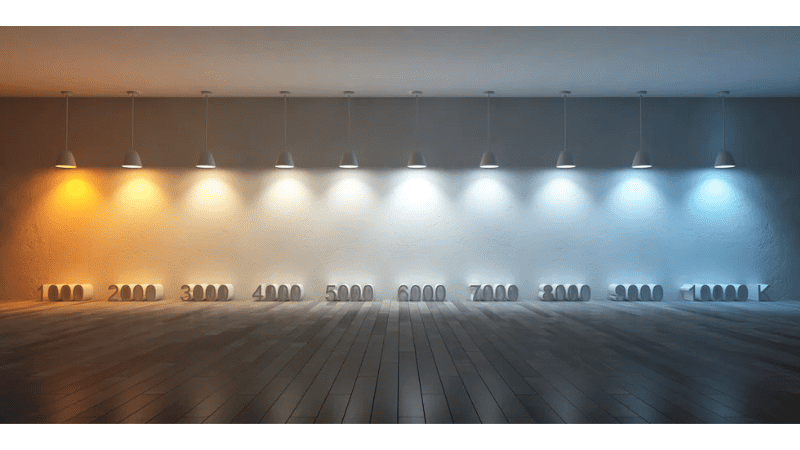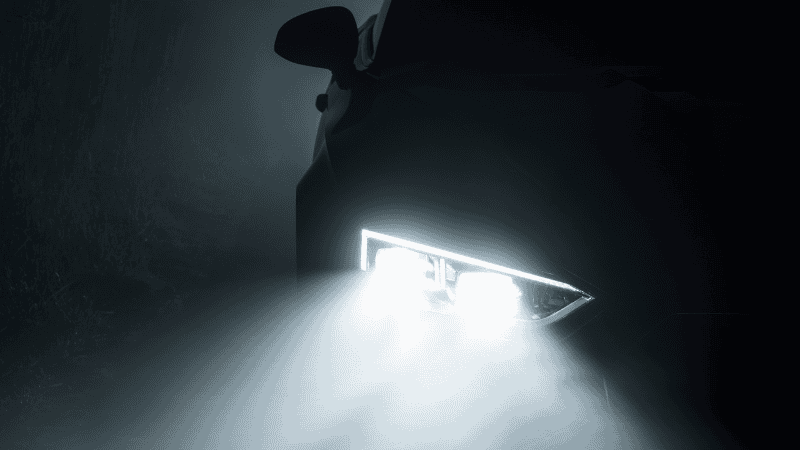In this guide, we will explain what color temperature (Kelvin) is, how it is calculated, and what its applications are in LED headlights. We will also discuss the pros and cons of various color temperatures and explain how to choose the right color temperature before buying LED headlights.
So continue reading to discover more!
What is Color Temperature?
When you are on the lookout for LED headlights, you will come across various LED color temperatures produced by the light source. So, what is the color temperature in LED headlights, anyway?
Well, despite its name, the light color temperatures of LED headlights do not have to do with their physical temperature. Instead, the color of the light emitted from LED light bulbs is known as color temperature. It represents light appearance rather than its temperature. It is measured in Kelvin (K), which is a unit of thermodynamic temperature.

This color temperature is measured on a scale from warm to cool. Warm or yellowish light is produced at lower color temperatures ranging from 2700K to 4000K. It is mostly used in task lighting. Whereas white or blue-white light is produced at higher Kelvin temperatures ranging from 5000K to 6500K.
Therefore, when choosing the right LED headlight, it is important to determine the color temperature as drivers have varying preferences. However, do note that higher color temperatures can make it affect the visibility of oncoming drivers, as they are harsher on the human eye as compared to lower color temperatures.
How is Kelvin Calculated?
The most common scale to measure color temperature in lighting is the Kelvin scale. It determines the color of light produced when a black body radiator reaches a certain temperature.
As this temperature increases, it produces cool light. And as it decreases, it produces yellowish light. So, the higher the Kelvin value, the whiter (bluer) the light. And the lower the Kelvin value, the warmer (yellowish) the light.

The Kelvin (K) scale is an absolute temperature scale, which means when the Kelvin temperature is zero, it is absolute zero, the coldest possible temperature where there is zero internal energy at the molecular motion level.
The measure of a degree in Kelvin is similar to that in Celsius. Zero Kelvin is equal to -273.15 Celsius. Therefore, you can subtract 273.15 from any Kelvin temperature to get a Celsius temperature.
For example, 500 Kelvin is equal to 226.85 Celsius (500 minus 273.15).
Color Temperatures in LED Headlights
Regarding LED headlights for vehicles, their Kelvin color temperature can impact the visibility and light output for both the driver and the oncoming traffic. Some people opt for cooler color temperatures as they offer brighter and clearer visibility at nighttime. However, it can be harsh on the eyes of oncoming drivers.

LED headlights come in various color temperature options. While the choice depends on the driver’s personal preference, it is also important to consider safety and visibility while driving.
Here are the most common Kelvin color temperatures available in LED headlights:
1. Warm White
Ranging from 2700K to 3000K, the warm color temperature range offers a yellow color light or warm light, also commonly known as “warm white.” It is quite similar to the incandescent bulbs available in the market. It is usually considered a safe option as it is easy on the eyes and offers decent visibility.
2. Neutral White
Ranging from 4000K to 4500K, this light temperature range offers natural daylight illumination. It offers good visibility and a perfect balance between cool and warm lights. It is ideal for [people looking for a balanced option between warm and cool white lights.
3. Cool White
Ranging from 4500K to 5500K, this light temperature range offers a bluish-white and cooler light. It is often preferred by nighttime drivers as it offers much higher visibility than warm white bulbs.
What’s more, it offers a high-tech aesthetic appeal and also comes factory-installed in most modern vehicles.

4. Daylight White
Starting from 5500K, this light temperature range offers a very cool and bluish light, which is commonly referred to as “daylight white.” It is extremely bright and offers the clearest visibility. However, it can be uncomfortable for the oncoming people and blind their vision for a few moments. Therefore, it is not recommended for driving.
Importance of Color Temperature in Driving

When choosing the LED headlight’s light temperature, it is important to consider both its benefits and drawbacks. Although higher color temperatures offer better and clearer visibility, they are also known to create glare and irritate the oncoming drivers.
What’s more, many countries have strict regulations on specific highways regarding the acceptable color temperatures for vehicle headlights. This is to ensure safe driving and prevent any accidents resulting from high-color temperature LED headlights that blind the oncoming drivers.
Therefore, make sure to check your local regulations and driving conditions before buying LED headlights. If you are an LED headlight dealer, make sure to opt for headlights that are allowed by your local authorities. Select a color temperature that matches your preferences and is also easy on the eyes of oncoming drivers.
Pros and Cons of Various Color Temperature
When it comes to the different color temperature options in LED headlights, each one has its pros and cons. Although the right selection may vary, depending on the driver’s preferences, you can make the right choice by considering the advantages and disadvantages of each option.
Below, we have listed the pros and cons of various color temperature options available in LED headlights. Let’s take a look!
Pros and Cons of Warm White LED Headlights
Pros
- More comfortable and cozy.
- Less harsh on the eyes of pedestrians and oncoming drivers.
- Less glare as compared to higher color temperature lights.
- Lower risk of blinding the oncoming drivers.
- Decent visibility during nighttime.
Cons
- Lower visibility as compared to cooler temperature lights, especially in extremely dark driving conditions.

Pros and Cons of Neutral White LED Headlights
Pros
- Balanced color temperature.
- Offers good visibility.
- Ideal for people looking for neither too cool nor too warm light options.
Cons
- Not selected by most drivers as it does not offer a distinct warm or cool light.
Pros and Cons of Cool White LED Headlights
Pros
- Much more improved visibility than warm or neutral white lights.
- Quite popular for nighttime driving.
- Offers a high-tech aesthetic appeal.
- Ideal for modern drivers.
Cons
- Increased glare.
- Uncomfortable to use for longer periods.
- Discomforting for the oncoming drivers.

Pros and Cons of Daylight White LED Headlights
Pros
- Maximum visibility as compared to all the other options.
- Higher precision and clarity for nighttime driving.
- Enhanced details and contrast.
- Crisp visibility.
Cons
- Extremely strong glare.
- Highly blinding for oncoming drivers and pedestrians.
- Extreme discomfort over extended periods.
- Not allowed on major highways in many countries.
Warm vs. Cool Light
| Color Temperature in Kelvin (K) | Light Appearance | Visibility | Ambiance | Glare Level |
|---|---|---|---|---|
| 2700-3000 | Warm White | Decent | Soft, comfortable | No glare |
| 4000-4500 | Neutral White | Good | Balanced | Low |
| 4500-5500 | Cool White | Really Good | Bright and crisp | High |
| 5500 and above | Daylight White | Excellent | Extremely bright and clear | Very high |
The table above shows the difference between warm and cool LED headlights. As you can tell, warm light headlights produce a yellowish light and offer a comfortable visibility that is not very straining on the eyes.
Warm lights are also comfortable for oncoming drivers as they produce little to no glare. What’s more, they give a classic appearance to the overall aesthetics of your vehicle.
On the other hand, cool light headlights produce a bright white light and offer crisp and bright visibility. They are ideal for nighttime driving and give a modern appearance to your vehicle.
However, they are more strenuous on the eyes and can also temporarily blind the oncoming drivers as they have a strong glare.
While the choice between warm and cool LED headlights depends on the specific driver, it is important to make the right decision by considering visibility, safety, local regulations, personal preference, and aesthetics.
Factors to Consider When Choosing the Right Color Temperature

When choosing the right color temperature for headlights, there are a lot of factors that should be considered for optimal visibility and safety during nighttime driving.
Below, we have listed the most important factors to consider when choosing the color temperature for headlights:
1. Visibility
When choosing the right color temperature for your vehicle’s headlights, it is important to consider its visibility. Warm lights are less harsh as they have a softer contrast with decent visibility.
For some drivers, warm lights are also less straining on their eyes and more comfortable. Therefore, they are ideal for such drivers.
2. Glare
Although higher color temperature lights offer better visibility, they can also cause excessive glare for the oncoming drivers. Therefore, it is important to choose a light that offers a perfect balance between brightness and reduced glare.
3. Compliance with Local Regulations

Another important factor to consider is compliance with local regulations. If you have selected a specific color temperature, make sure it complies with the local regulations. Many countries have specific regulations regarding the acceptable color temperature for headlights.
4. Personal Preference
Personal preference is yet another important factor when buying LED headlights. While most drivers prefer warmer color temperatures for a comfortable and safe driving experience, others opt for cooler temperatures to get a crisp and brightly lit environment.
5. Vehicle Appearance
In addition to all of the above mentioned factors, it is also important to consider the overall aesthetics of your car. The color of the headlight should complement the overall appearance of your vehicle. Most modern cars look the best with cooler color temperatures.
6. Driving Conditions

It is also important to consider the driving conditions you typically drive in. If you mostly drive during the nighttime, it is better to opt for cooler color temperatures for better visibility. But if you don’t drive much during the nighttime, it is safe to go for warmer color temperatures.
You should also consider the common weather conditions in your area. If you get a lot of rain or foggy weather conditions, it is best to opt for yellowish or warm headlights as they offer better visibility in such weather conditions.
7. Cost
Another important factor to consider when buying LED headlights is their cost and maintenance. While LED lighting has a longer lifespan, its color temperature can affect the longevity of the light bulb. So, make sure to choose a balanced option between the bulb’s lifespan and your color preference.
By considering these factors before buying a headlight with the right color temperature, you can make the right decision that offers both safety and comfort when driving.
Conclusion
So that’s all, folks! Now that you know what color temperature is in headlights, how it makes a difference, and what the different headlight color temperatures are, you can make an informed decision by weighing the pros and cons of each option.
While selecting the right color temperature for an LED headlight depends on the driver’s preference, it is also important to consider the local traffic and vehicle regulations, especially if you are a local dealership.
For more info on LED headlights, check out our resources.
Buy High-Quality LED Headlights From Carlightvision
At Carlightvision, we redefine your driving experience with LED headlights that aren’t just normal beams. With our headlights, you can picture a breathtaking driving experience with safety, style, visibility, and longevity converging into one radiant beam.
Our LED headlights are available in various color temperature options and surpass the standards of safety and modern allure. So don’t settle for less! Choose brilliance and innovation by getting your LED headlights from us. Contact us today to source quality headlights for your business or dealership.



